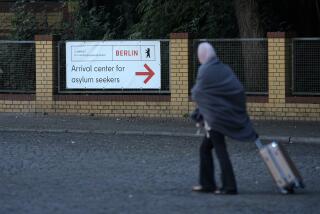New Day Dawns at Wall for Checkpoint Charlie Museum
- Share via
WEST BERLIN — After 28 years of campaigning, West Berlin’s Checkpoint Charlie Museum can finally get down to business. The business, that is, of being a museum.
Standing just 50 yards from Europe’s most famous East-West crossing point, the Checkpoint Charlie Museum has long been a focal point for the campaign to open up the Berlin Wall.
Its run-down premises have been the site of scores of news conferences introducing escapees from the East to the Western press and trying to push home the message of the misery caused by the wall.
Then on Nov. 9, its battle was suddenly won. The East German government made a shock decision to open its frontiers, giving East Germany’s 16 million people their first chance in 28 years to travel freely to the West.
“I only slept an hour that night. As a German, it was a wonderful experience,” said Rainer Hildebrandt, who founded the museum in December, 1961, four months after the wall was built.
With the wall now open at 15 points around the city, Hildebrandt’s campaign for free travel between East and West Berlin is almost over.
“Now we have to struggle for the 500 political prisoners who have not got out of East Germany; this is the only problem. But I’m sure there will be enough noise to get them out,” Hildebrandt said.
East Germany denies that it has any political prisoners.
After that, Hildebrandt says, the Checkpoint Charlie Museum can simply be a memorial to the thousands of successful escapes from Eastern Europe during the last three decades.
“We are lucky enough to have a monopoly. The official museums have always avoided the wall. They were always afraid of being considered right-wing,” he said.
Although East Germans flooding across Checkpoint Charlie so far seem reluctant to stop off at the museum, more than 1,000 people, mostly foreigners, shuffle past the exhibits every day.
It is a powerful monument to human ingenuity, with its collection of escape tools reflecting the words on a sign above one exhibit: “Escape Is the Mother of Invention.”
Among them is the old English Alvis motorcycle in which Friedl Linke of Dresden made it to the West in 1969. Linke was hidden in the fuel tank.
There are also the two hollowed-out surfboards in which 25-year-old Helke Dittrich escaped from East Germany 18 years later. She married the West German who smuggled her out.
A total of 80 people died trying to cross the Berlin Wall, the last of them only this year.
“There was a young man who tried to get across in February. He was hit by 39 bullets,” Hildebrandt said, still shaking in anger. “Can you imagine how his parents feel now?”
The museum is also a memorial to escapes that went wrong, and for that reason most of the exhibits are from escapes that occurred away from the city.
Hildebrandt and his friends in the August 13 Community Action Group--named after the date in 1961 when the East Germans first built the Wall--always made a point of discouraging people from trying to cross it.
“We said it clearly: It’s too dangerous. Statistically, it was eight times safer passing through a third country like Hungary,” he said.
In numerical terms, the most successful escapes from East Berlin were through tunnels under no-man’s land in the early days. In 1962, 57 people tunneled to the West in 48 hours before East German authorities discovered their escape route.
Of all the thousands of escapes, however, Hildebrandt likes to tell the story of one--”the easiest and most original.”
It happened one day in 1967 when a young East German marched boldly into Checkpoint Charlie, passing by several sets of controls before being stopped by a guard.
He told the guard he was an Austrian going to see his dying mother in the west of the city, adding that he had already turned his passport in for checks. The guard called two colleagues to look after him and went off to look for the missing passport.
“What’s your problem then?” one of the arriving guards asked.
The young man promptly changed his story.
“I am an Austrian and I’ve just heard my mother is dying in East Berlin. The problem is I’ve not got my passport on me,” he said.
“They’ll never let you in!” the guard declared. “I’d just head back west if I were you and fetch it.”
More to Read
Sign up for The Wild
We’ll help you find the best places to hike, bike and run, as well as the perfect silent spots for meditation and yoga.
You may occasionally receive promotional content from the Los Angeles Times.






